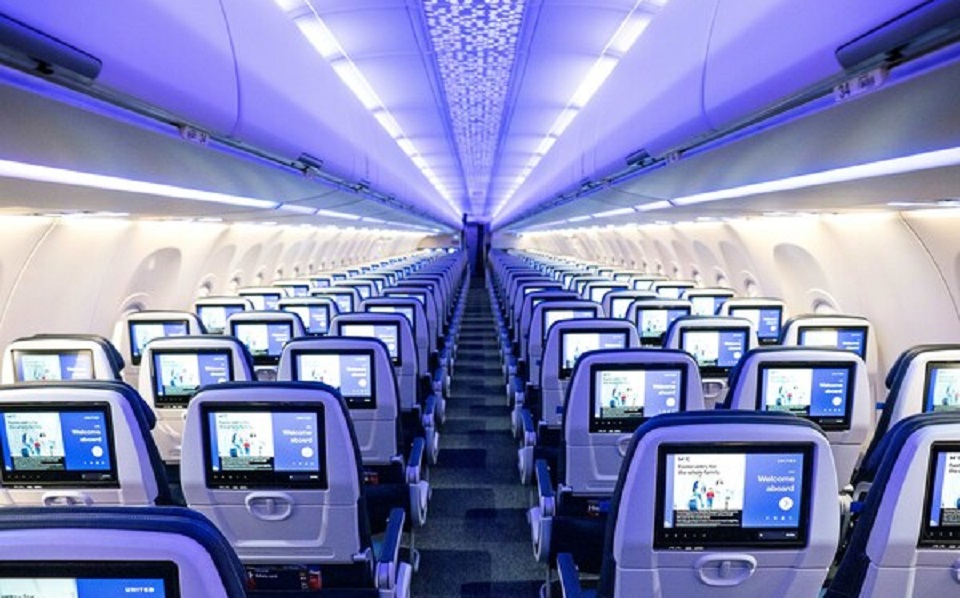Aerospace
Is United Airlines implementing a self-serve snack bar on its latest A321neo?

United Airlines is addressing the challenges faced by airline crews in serving passengers, a task that can be quite demanding and lead to fatigue.
To enhance passenger experience and alleviate crew workload, the airline is introducing an innovative product—an onboard self-serve snack bar.
Implement this new approach on its latest aircraft
Currently in the trial and testing phase with airline staff, the self-serve snack bar aims to gauge its convenience for in-flight service. United Airlines is set to implement this new approach on its latest aircraft, the Airbus A321neo.
Passengers will have the opportunity to independently access complimentary refreshments without relying on flight attendants to bring them.
The airline emphasizes that the kiosks will provide a limited supply of water and snacks typically offered during complimentary service.
Piloting this concept on its Airbus A321neo
This forward-thinking initiative aims to reduce crew fatigue, addressing the challenges associated with accommodating various passenger demands during in-flight service.
The self-serve kiosk will only become accessible after the airline staff completes their initial round of service. This new approach marks a departure from the traditional method of waiting for the cabin crew to navigate the aisle with a food and beverage cart.
United Airlines is piloting this concept on its Airbus A321neo, with the inaugural flight scheduled for November 30 departing from Chicago O’Hare International Airport.
The new aircraft also offers:
- United’s new domestic first-class seat, with wireless charging and more privacy
- Larger overhead bins with space for every passenger’s roll aboard bag
- High-speed Wi-Fi with streaming capabilities
- Bluetooth connectivity
- LED lighting designed to create a modern, calming atmosphere
The A321neo is just the latest addition to United’s fleet as progress continues on the airline’s ambitious United Next growth strategy; United expects to take delivery of about 800 new narrowbody and widebody aircraft between 2023 and the end of 2032, while retrofitting existing narrowbody aircraft with United’s Signature Interior.

Aerospace
Boeing Transfers Rocket Stage to NASA, Paving Way for Human Moon Mission

Boeing has achieved a significant milestone by providing NASA with the second core stage of the Space Launch System (SLS) rocket.
This crucial component, crafted at NASA’s Michoud Assembly Facility (MAF), is set to propel the Artemis II crew into lunar orbit, marking humanity’s return to deep space after a 50-year hiatus.
The monumental Boeing-built rocket stage, the largest element of the Artemis II mission, will embark on a journey aboard the Pegasus barge, traveling 900 miles to NASA’s Kennedy Space Center.
Comparison of two legendary aircraft B777x vs B747 aircraft:Click here
Upon arrival, it will be meticulously integrated with other essential Artemis II components, including the upper stage, solid rocket boosters, and NASA’s Orion spacecraft within the iconic Vehicle Assembly Building. This intricate integration process is a vital step toward the eagerly anticipated Artemis II launch, slated for 2025.
“Boeing-built products helped land humankind on the moon in 1969, and we’re proud to continue that legacy through the Artemis generation,” remarked Dave Dutcher, vice president and program manager for Boeing’s SLS program. “Together, with NASA and our industry partners and suppliers, we are building the world’s most capable rocket and paving the way to deep space through America’s rocket factory in New Orleans.”
NASA, Lockheed Martin Reveal X-59 Quiet Supersonic Aircraft:Click here
The delivery of Core Stage 2 marks a significant achievement in the evolution of the SLS rocket. Towering over 200 feet and powered by four RS-25 engines, this core stage, coupled with two solid-fueled booster rockets, will generate a staggering 8.8 million pounds of thrust. This immense power is crucial to launching Artemis II and future missions into the vast expanse of space.
The SLS rocket stands unparalleled in its capability to transport both crew and substantial cargo to the moon and beyond in a single launch. Its extraordinary capacity will facilitate the delivery of human-rated spacecraft, habitats, and scientific missions to destinations including the moon and Mars, ushering in a new era of space exploration.
-

 Travel1 week ago
Travel1 week agoAir India to Expand US Operations with Three New Routes After a Decade
-

 Travel2 weeks ago
Travel2 weeks agoWhy We Should Avoid These Stamps in a Passport
-

 Airlines1 month ago
Airlines1 month agoInvestigations Reveal Fake Chinese Titanium in Boeing and Airbus Jets
-

 Tech4 weeks ago
Tech4 weeks agoChina’s CATL Plans 1,800-Mile Electric Plane Launch by 2027
-

 Airport3 days ago
Airport3 days agoTop 10 Largest Airports in the World by Size
-

 Aerospace4 weeks ago
Aerospace4 weeks agoChina’s Fighter Jets Turn Wings into Autonomous Drones
-

 Airlines4 days ago
Airlines4 days agoAir India Rolls Out A350s for Delhi-New York JFK and Newark Routes
-

 Defence3 weeks ago
Defence3 weeks agoBoeing Enhances Chinook with New Engines and Block II Upgrades at $96 Million







